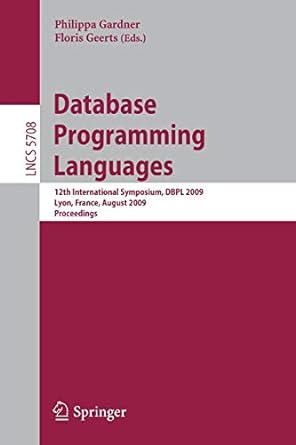SUBJECT: TECHNICAL BUSINESS WRITING
Design a usability test for user manual (of ANY APPLICATION), conduct it, and then write up the report following the following format (report should not be less than 1500 words)
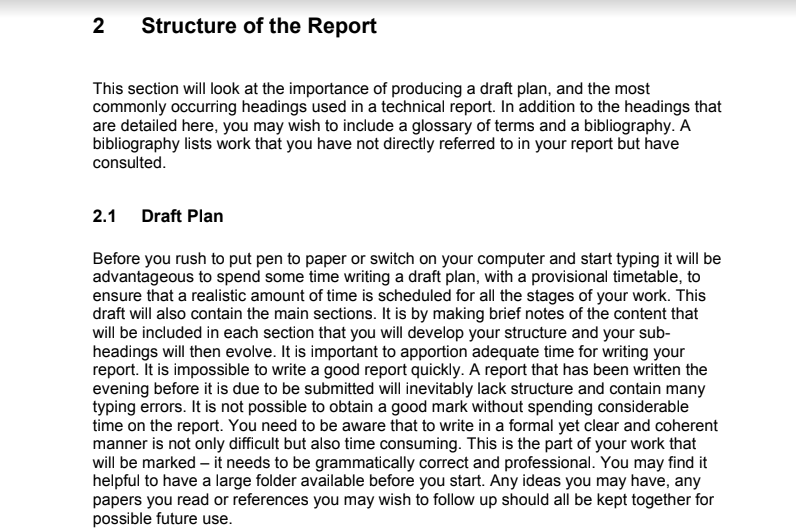
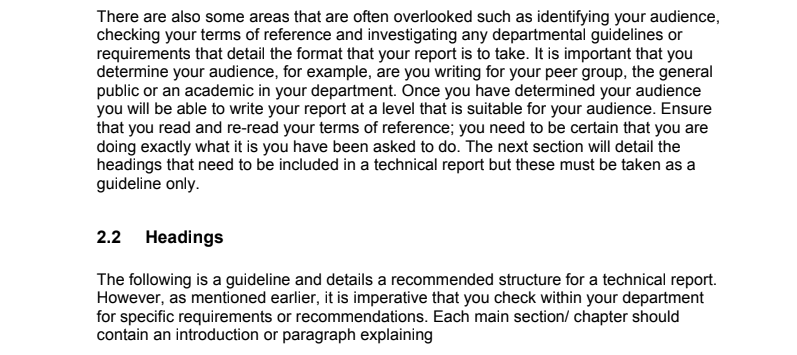
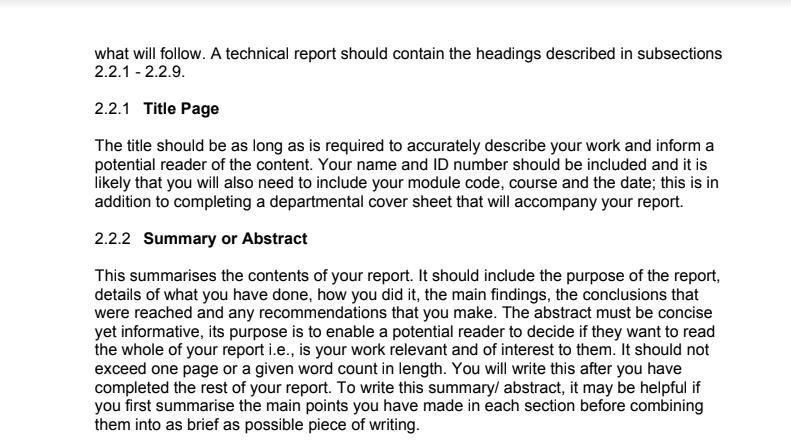
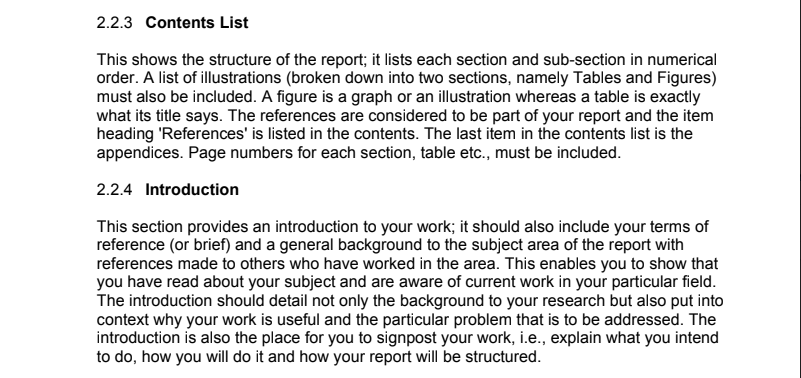
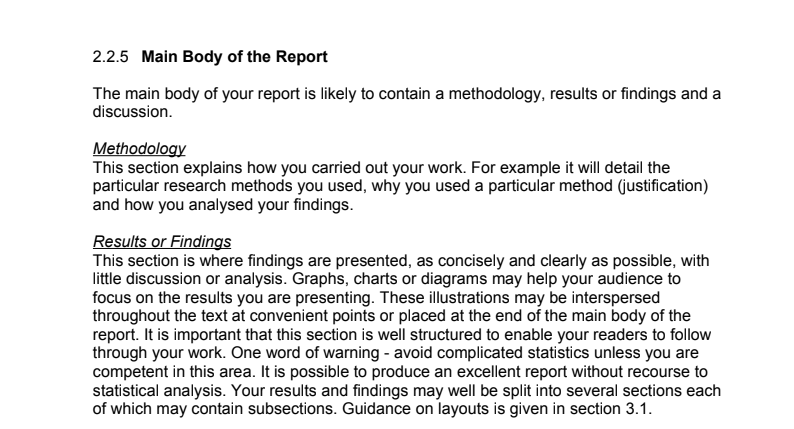


2 Structure of the Report This section will look at the importance of producing a draft plan, and the most commonly occurring headings used in a technical report. In addition to the headings that are detailed here, you may wish to include a glossary of terms and a bibliography. A bibliography lists work that you have not directly referred to in your report but have consulted. 2.1 Draft Plan Before you rush to put pen to paper or switch on your computer and start typing it will be advantageous to spend some time writing a draft plan, with a provisional timetable, to ensure that a realistic amount of time is scheduled for all the stages of your work. This draft will also contain the main sections. It is by making brief notes of the content that will be included in each section that you will develop your structure and your sub- headings will then evolve. It is important to apportion adequate time for writing your report. It is impossible to write a good report quickly. A report that has been written the evening before it is due to be submitted will inevitably lack structure and contain many typing errors. It is not possible to obtain a good mark without spending considerable time on the report. You need to be aware that to write in a formal yet clear and coherent manner is not only difficult but also time consuming. This is the part of your work that will be marked - it needs to be grammatically correct and professional. You may find it helpful to have a large folder available before you start. Any ideas you may have, any papers you read or references you may wish to follow up should all be kept together for possible future use. There are also some areas that are often overlooked such as identifying your audience, checking your terms of reference and investigating any departmental guidelines or requirements that detail the format that your report is to take. It is important that you determine your audience, for example, are you writing for your peer group, the general public or an academic in your department. Once you have determined your audience you will be able to write your report at a level that is suitable for your audience. Ensure that you read and re-read your terms of reference; you need to be certain that you are doing exactly what it is you have been asked to do. The next section will detail the headings that need to be included in a technical report but these must be taken as a guideline only. 2.2 Headings The following is a guideline and details a recommended structure for a technical report. However, as mentioned earlier, it is imperative that you check within your department for specific requirements or recommendations. Each main section/ chapter should contain an introduction or paragraph explaining what will follow. A technical report should contain the headings described in subsections 2.2.1 -2.2.9. 2.2.1 Title Page The title should be as long as is required to accurately describe your work and inform a potential reader of the content. Your name and ID number should be included and it is likely that you will also need to include your module code, course and the date; this is in addition to completing a departmental cover sheet that will accompany your report. 2.2.2 Summary or Abstract This summarises the contents of your report. It should include the purpose of the report, details of what you have done, how you did it, the main findings, the conclusions that were reached and any recommendations that you make. The abstract must be concise yet informative, its purpose is to enable a potential reader to decide if they want to read the whole of your report i.e., is your work relevant and of interest to them. It should not exceed one page or a given word count in length. You will write this after you have completed the rest of your report. To write this summaryl abstract, it may be helpful if you first summarise the main points you have made in each section before combining them into as brief as possible piece of writing. 2.2.3 Contents List This shows the structure of the report; it lists each section and sub-section in numerical order. A list of illustrations (broken down into two sections, namely Tables and Figures) must also be included. A figure is a graph or an illustration whereas a table is exactly what its title says. The references are considered to be part of your report and the item heading 'References' is listed in the contents. The last item in the contents list is the appendices. Page numbers for each section, table etc., must be included. 2.2.4 Introduction This section provides an introduction to your work; it should also include your terms of reference (or brief) and a general background to the subject area of the report with references made to others who have worked in the area. This enables you to show that you have read about your subject and are aware of current work in your particular field. The introduction should detail not only the background to your research but also put into context why your work is useful and the particular problem that is to be addressed. The introduction is also the place for you to signpost your work, i.e., explain what you intend to do, how you will do it and how your report will be structured. 2.2.5 Main Body of the Report The main body of your report is likely to contain a methodology, results or findings and a discussion. Methodology This section explains how you carried out your work. For example it will detail the particular research methods you used, why you used a particular method (justification) and how you analysed your findings. Results or Findings This section is where findings are presented, as concisely and clearly as possible, with little discussion or analysis. Graphs, charts or diagrams may help your audience to focus on the results you are presenting. These illustrations may be interspersed throughout the text at convenient points or placed at the end of the main body of the report. It is important that this section is well structured to enable your readers to follow through your work. One word of warning - avoid complicated statistics unless you are competent in this area. It is possible to produce an excellent report without recourse to statistical analysis. Your results and findings may well be split into several sections each of which may contain subsections. Guidance on layouts is given in section 3.1. Discussion This section discusses the results you have obtained and reported. For example, were the results as anticipated or were they unexpected? You can now analyse your data and interpret your results. For instance, was the technology you used of a high enough specification to enable your results to be of a particular accuracy? If there are any unexpected results or discrepancies you should suggest reasons why these have occurred. Were there any time or funding constraints? If so you should mention this in your discussion - this ensures that those who read your report are aware of any shortcomings there may be. It will also remind you not to make any exaggerated claims about your findings. It is important that you present a realistic interpretation of your results, link them to what you were aiming to discover and if appropriate compare these findings to those of others. This is an opportunity to refer back to what you said in your introduction. Remember to refer back to your original brief, it is important that you either show that you have done what was required or explain the reasons for inconclusive or unusual results. 2.2.6 Conclusion and Recommendations In your conclusion you will need to explain how your findings address the task or objective that you were posed. Your conclusion should not contain mention of any results that have not already been presented; the aim is to draw out possible implications from your findings and to present them clearly and succinctly. Point out what you have achieved. You may also make recommendations for future work; this is particularly useful if your own results were inconclusive. For example, you could suggest that your work is repeated with more sensitive equipment, over a longer time scale or with more funding. 2.2.7 References The References section is the final part of your report that is included in the word or page count if one has been given. In the introduction a particular experiment or result 2.2.8 Acknowledgements This is where you acknowledge any help and support you have received whether from your supervisor, colleagues or external bodies. For instance, you may have been loaned a piece of equipment, you may have received technical support or financial help. There are two schools of thought on where the acknowledgements should be placed. They may be included after the title page or after the references. 2.2.9 Appendices The appendices appear at the end of your report and are where you place supporting information such as memos and questionnaires. This ensures that your actual report contains the most relevant material but the opportunity to view all the material is available for those who want to avail themselves of it (this is likely to be your lecturer). You may have more than one appendix and these may be labelled in an alphabetic or numeric system (but not a combination of both), for example Appendix 1, Appendix 2 or Appendix A. Appendix B. A title describing the contents of each appendix must also be included. It must be possible to understand the report without recourse to the appendices. The appendices should not contain any material that has not been previously mentioned in your report. Example 1: in your methodology you could discuss the questions that are to be posed then mention that the questionnaire may be viewed in Appendix A. Example 2: you could mention, for instance, that the manager of SupaSlik was contacted and permission was sought to view the manufacturing process and then continue by writing that a copy of the memo may be viewed in Appendix B. The appendices are not included in the allowed word or page count. However, they must be listed on the contents page and be of the same high standard as your report. 2 Structure of the Report This section will look at the importance of producing a draft plan, and the most commonly occurring headings used in a technical report. In addition to the headings that are detailed here, you may wish to include a glossary of terms and a bibliography. A bibliography lists work that you have not directly referred to in your report but have consulted. 2.1 Draft Plan Before you rush to put pen to paper or switch on your computer and start typing it will be advantageous to spend some time writing a draft plan, with a provisional timetable, to ensure that a realistic amount of time is scheduled for all the stages of your work. This draft will also contain the main sections. It is by making brief notes of the content that will be included in each section that you will develop your structure and your sub- headings will then evolve. It is important to apportion adequate time for writing your report. It is impossible to write a good report quickly. A report that has been written the evening before it is due to be submitted will inevitably lack structure and contain many typing errors. It is not possible to obtain a good mark without spending considerable time on the report. You need to be aware that to write in a formal yet clear and coherent manner is not only difficult but also time consuming. This is the part of your work that will be marked - it needs to be grammatically correct and professional. You may find it helpful to have a large folder available before you start. Any ideas you may have, any papers you read or references you may wish to follow up should all be kept together for possible future use. There are also some areas that are often overlooked such as identifying your audience, checking your terms of reference and investigating any departmental guidelines or requirements that detail the format that your report is to take. It is important that you determine your audience, for example, are you writing for your peer group, the general public or an academic in your department. Once you have determined your audience you will be able to write your report at a level that is suitable for your audience. Ensure that you read and re-read your terms of reference; you need to be certain that you are doing exactly what it is you have been asked to do. The next section will detail the headings that need to be included in a technical report but these must be taken as a guideline only. 2.2 Headings The following is a guideline and details a recommended structure for a technical report. However, as mentioned earlier, it is imperative that you check within your department for specific requirements or recommendations. Each main section/ chapter should contain an introduction or paragraph explaining what will follow. A technical report should contain the headings described in subsections 2.2.1 -2.2.9. 2.2.1 Title Page The title should be as long as is required to accurately describe your work and inform a potential reader of the content. Your name and ID number should be included and it is likely that you will also need to include your module code, course and the date; this is in addition to completing a departmental cover sheet that will accompany your report. 2.2.2 Summary or Abstract This summarises the contents of your report. It should include the purpose of the report, details of what you have done, how you did it, the main findings, the conclusions that were reached and any recommendations that you make. The abstract must be concise yet informative, its purpose is to enable a potential reader to decide if they want to read the whole of your report i.e., is your work relevant and of interest to them. It should not exceed one page or a given word count in length. You will write this after you have completed the rest of your report. To write this summaryl abstract, it may be helpful if you first summarise the main points you have made in each section before combining them into as brief as possible piece of writing. 2.2.3 Contents List This shows the structure of the report; it lists each section and sub-section in numerical order. A list of illustrations (broken down into two sections, namely Tables and Figures) must also be included. A figure is a graph or an illustration whereas a table is exactly what its title says. The references are considered to be part of your report and the item heading 'References' is listed in the contents. The last item in the contents list is the appendices. Page numbers for each section, table etc., must be included. 2.2.4 Introduction This section provides an introduction to your work; it should also include your terms of reference (or brief) and a general background to the subject area of the report with references made to others who have worked in the area. This enables you to show that you have read about your subject and are aware of current work in your particular field. The introduction should detail not only the background to your research but also put into context why your work is useful and the particular problem that is to be addressed. The introduction is also the place for you to signpost your work, i.e., explain what you intend to do, how you will do it and how your report will be structured. 2.2.5 Main Body of the Report The main body of your report is likely to contain a methodology, results or findings and a discussion. Methodology This section explains how you carried out your work. For example it will detail the particular research methods you used, why you used a particular method (justification) and how you analysed your findings. Results or Findings This section is where findings are presented, as concisely and clearly as possible, with little discussion or analysis. Graphs, charts or diagrams may help your audience to focus on the results you are presenting. These illustrations may be interspersed throughout the text at convenient points or placed at the end of the main body of the report. It is important that this section is well structured to enable your readers to follow through your work. One word of warning - avoid complicated statistics unless you are competent in this area. It is possible to produce an excellent report without recourse to statistical analysis. Your results and findings may well be split into several sections each of which may contain subsections. Guidance on layouts is given in section 3.1. Discussion This section discusses the results you have obtained and reported. For example, were the results as anticipated or were they unexpected? You can now analyse your data and interpret your results. For instance, was the technology you used of a high enough specification to enable your results to be of a particular accuracy? If there are any unexpected results or discrepancies you should suggest reasons why these have occurred. Were there any time or funding constraints? If so you should mention this in your discussion - this ensures that those who read your report are aware of any shortcomings there may be. It will also remind you not to make any exaggerated claims about your findings. It is important that you present a realistic interpretation of your results, link them to what you were aiming to discover and if appropriate compare these findings to those of others. This is an opportunity to refer back to what you said in your introduction. Remember to refer back to your original brief, it is important that you either show that you have done what was required or explain the reasons for inconclusive or unusual results. 2.2.6 Conclusion and Recommendations In your conclusion you will need to explain how your findings address the task or objective that you were posed. Your conclusion should not contain mention of any results that have not already been presented; the aim is to draw out possible implications from your findings and to present them clearly and succinctly. Point out what you have achieved. You may also make recommendations for future work; this is particularly useful if your own results were inconclusive. For example, you could suggest that your work is repeated with more sensitive equipment, over a longer time scale or with more funding. 2.2.7 References The References section is the final part of your report that is included in the word or page count if one has been given. In the introduction a particular experiment or result 2.2.8 Acknowledgements This is where you acknowledge any help and support you have received whether from your supervisor, colleagues or external bodies. For instance, you may have been loaned a piece of equipment, you may have received technical support or financial help. There are two schools of thought on where the acknowledgements should be placed. They may be included after the title page or after the references. 2.2.9 Appendices The appendices appear at the end of your report and are where you place supporting information such as memos and questionnaires. This ensures that your actual report contains the most relevant material but the opportunity to view all the material is available for those who want to avail themselves of it (this is likely to be your lecturer). You may have more than one appendix and these may be labelled in an alphabetic or numeric system (but not a combination of both), for example Appendix 1, Appendix 2 or Appendix A. Appendix B. A title describing the contents of each appendix must also be included. It must be possible to understand the report without recourse to the appendices. The appendices should not contain any material that has not been previously mentioned in your report. Example 1: in your methodology you could discuss the questions that are to be posed then mention that the questionnaire may be viewed in Appendix A. Example 2: you could mention, for instance, that the manager of SupaSlik was contacted and permission was sought to view the manufacturing process and then continue by writing that a copy of the memo may be viewed in Appendix B. The appendices are not included in the allowed word or page count. However, they must be listed on the contents page and be of the same high standard as your report













